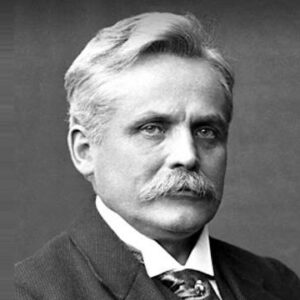Wilhelm Wien was a German physicist who did important work in thermal radiation and won the Nobel Prize in Physics for it. He is best known for the Wien’s distribution law and the Wien’s displacement law (also known as the Wien approximation). Even though he learned at home as a child and was kicked out of his first school for not doing well in school, he did important work in the field of physics. After getting his Ph.D. under the guidance of the famous physicist Herman Helmholtz, he worked as his assistant and later taught physics at some of the best universities in the world. He did groundbreaking research in the field of thermal radiation and proposed laws about the relationship between a body’s wavelength and temperature. He also explained what a blackbody is. A blackbody is a body that absorbs all radiation and gives off heat. He helped come up with a correct expression for the blackbody radiation in the photon-gas limit. He won the Nobel Prize in Physics for his “displacement law” about how a perfectly efficient blackbody gives off radiation. He also made important discoveries about cathode rays, X-rays, and canal rays (positively charged atomic beams). His amazing discoveries were very important to the growth of quantum mechanics.
Early years and childhood
On January 13, 1864, he was born in Geffken, East Prussia, near the small town of Fischbach, to Carl Wien, a landowner, and Caroline Gertz, his wife. He was the only kid they had.
When he was a child, his family moved to a small farm in Drakenstein. He learned at home until he was eleven years old. His parents paid for a private teacher to teach him, French.
In 1879, he went to school in Rastenburg, but he was soon kicked out because he wasn’t doing well in school. Later in 1880, he went to the city school in Heidelberg, where he stayed until 1882 when he graduated.
He went to the University of Gottingen in 1882 to study math and science. In the same year, he also went to school to learn about physics at the University of Berlin.
From 1883 to 1885, he went to school at the University of Berlin and worked in the lab of Hermann von Helmholtz, a German physicist, and mathematician.
He got his Ph.D. in physics from the University of Berlin in 1886 with a paper called “The Diffraction of Light on Photographically Reduced Lattices.”
After getting his Ph.D., he went back to his family farm, which had been badly damaged by a fire, to help fix it up. During the next four years, he tried to fix up the farm while also studying physics on his own. In 1890, he was forced to sell the land because it was in bad shape.
Wilhelm Wien’s Career
In 1890, Helmholtz made him his assistant at the State Physical-Technical Institute in Charlottenburg, which had just been set up.
He taught at the Rheinisch-Westfälische Technische Hochschule Aachen and the University of Giessen from 1896 to 1899.
In 1900, Wilhelm Röntgen, another German physicist, asked him to take over as a joint professor of physics at the University of Würzburg.
In 1902, he was asked to replace Ludwig Boltzmann as Professor of Physics at the University of Leipzig. In 1906, he was asked to replace Drude as Professor of Physics at the University of Berlin. He turned down both of these offers.
He was also the head of the University of Würzburg from 1913 to 1914. He went to the United States in 1913 to give a lecture at Columbia University.
In 1920, he was hired as a physics professor at the University of Munich, taking over a job that Roentgen had held before.
He was also made the head of the University of Munich from 1925 to 1926. He was in charge of building a new physics institute in Munich while he was there.
From 1906 until his death in 1928, he was also the co-editor of the journal Annalen der Physik.
Works of note
“Wien’s Displacement Law” is his most famous contribution to the study of thermal radiation. It shows a relationship between the temperature of a Planck Blackbody and the wavelength that shows the most radiated power. It says that as the temperature goes up, the blackbody’s light waves get shorter.
He also came up with a theory called “Wien’s Energy Distribution Law” that gave a graphical explanation of the energy distribution curve. The theory was correct, but only for wavelengths that were short. Later, Max Planck fixed the theory so that it worked for both short and long wavelengths. This was called “Planck’s law,” and it also led to the development of quantum theory.
Awards & Achievements
In 1911, he won the Nobel Prize in Physics “for his discoveries about the rules for how heat travels.”
Personal History and Legacies
In 1898, he married Luise Mehler, an Aix-la-Chapelle woman he had been with for a long time. They were lucky to have four kids. Their names were Gerda, Hildegard, Karl, and Waltraut.
During his time at Würzburg, he went on many trips to Spain, England, Italy, and Greece, among other European countries. At Würzburg, he also had time to study History and the Arts, which were things he had always been interested in.
He died in Munich, Germany, on August 30, 1928. He was 64 years old.
Estimated Net worth
Wilhelm’s main source of income is Celebrity. 2019 estimated net worth has $1 million.


